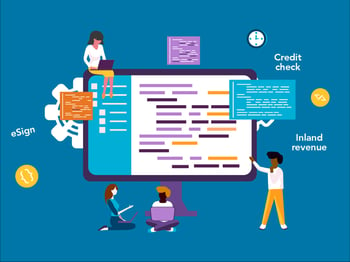Part of the Beyond Transformation series
With Jim Render, Regional Sales Manager, Q2 ANZ
Having a robust and comprehensive digitisation strategy is more critical than ever. With companies facing the realities of low interest rates, legacy technology systems, and a mountain of bad debt, they need to quickly take the lessons learned from the pandemic and transition to faster digital transformation. But it’s not a one size fits all approach. In this article, Jim Render, Regional Sales Manager at Q2 ANZ, shares the unique challenges and biggest opportunities for Australian lenders looking to make digitisation work for them in 2021 and beyond.
Australia’s unique challenges
Australia’s geopolitical and economic realities provide a unique set of challenges for tackling the next normal in commercial lending. With immigration and GDP shrinking during the pandemic, Australia was plunged into its first recession in nearly 30 years. Now firmly on the rebound, Australia still only trails Switzerland in terms of the highest per capita debt. The upside in all this is that Australia has retained its AAA credit rating throughout the pandemic, one of only nine countries to have such a rating from all three main agencies: S&P, Moody’s Investors Service and Fitch Ratings. This rating means that borrowing is still relatively easy due to the low-interest environment.
The key to addressing the economic fallout is enhanced coordination between the public and private sectors. Historically, Australia’s economic growth efforts have been led by private sector initiatives, without much political will power to match. This trend cannot hold in the new financial reality. Jim Render believes one major area of focus needs to be investment in large-scale and long-term infrastructure projects. The positive result of this is two-fold: it both stimulates credit and creates new jobs.
Faster digitisation
A recurring theme of the pandemic is the need to accelerate digitisation. Although discussions around faster digitisation began long before 2020, they were mainly focused on creating mobile-first platforms and improving user experiences. Now, digitisation is a high priority, deemed essential to business survival. Render stresses, “It's not just about digitising the front end. It’s the realisation that unless you have modern technology and infrastructure, businesses just can't service their clients and they can't allow their staff to work effectively from home anymore.”
Backend legacy systems are receiving attention, too. In order to make it in this new economic reality, companies must innovate on the back-end to decrease their manual processes and reallocate those resources effectively. Render emphasises the conversations taking place today are not being driven by customer experience as much as they are about organisational change. Business models will continue to be threatened if newer, automated systems are not quickly adopted with companies receiving fast ROI.
Commercial vs. consumer trends
Although there are some marked differences in Australia between commercial and consumer trends, namely the commercial focus on real estate, there are many more similarities. Low interest rates and the tapering off of government assistance programs exposes a significant credit risk. Both consumer and commercial businesses are concerned with collections and struggling to predict how likely their customers are to default.
Comparisons to the 2008 Global Financial Crisis are rife, and Render observes, “This current situation may be similar. A credit crunch happens because all of these borrowers can't pay back. What happens then is that the risk premium on loans goes up and then the wholesale funding markets have no money to lend.” Now that the recession has faded and Australia finds itself in rapid recovery, lenders need to stay innovative and intently focused on addressing credit decisioning and collections.
Biggest challenges ahead
Speed to innovation remains a major consideration for companies looking to not only survive, but thrive in 2021 and beyond. It is particularly important in meeting two challenges in tackling collections and bad debt:
- The first is organisational: Does your company have the right people and processes in place?
- The second is functional: Does your company know how to manage its books?
Both require efficiency from internal decision makers and the ability to integrate new technologies faster. Render finds fast-acting companies that were ahead of the curve immediately revised their credit matrices and decisioning, reallocating where they wanted their risk profiles to be. These iterations are only possible if flexible systems are in place to facilitate the changes. But recategorising borrowers in terms of who can (and cannot) repay their loans is only half the exercise.
Innovation also is needed in restructuring siloed data systems. Render points out, “The reality for most financial institutions is that they have really poor-quality data because they have disparate systems.” Until businesses choose to put data and analytics at heart of every important decision, they will continue to face inefficacies and lost market share.
Customer experience, where does it fit?
The ability for lenders to react in a responsible way that fulfills regulatory requirements, while giving customers a humane and quality experience in a time of hardship, is a good long-term strategy. Innovation is helping shape this strategy in these uncertain times.
One likely long-term outcome of the pandemic will be staff members' preference to work remotely, or at least to utilise a hybrid work model. Technology is needed to support this shift. More automation is being used with varying degrees of success. Customers, meanwhile, are now relying more heavily on their digital and mobile banking experiences, interfacing with chatbots and self-service widgets.
Render declares that whether it be a staff member, or a customer, compassion and flexibility are needed when addressing lending and repayments in Australia and elsewhere. The right technology can aid this effort.
These insights will help as you consider unique challenges for your digital lending transformation and beyond.
Learn more about Q2 and our approach to digital lending by visiting our Beyond Transformation website.





